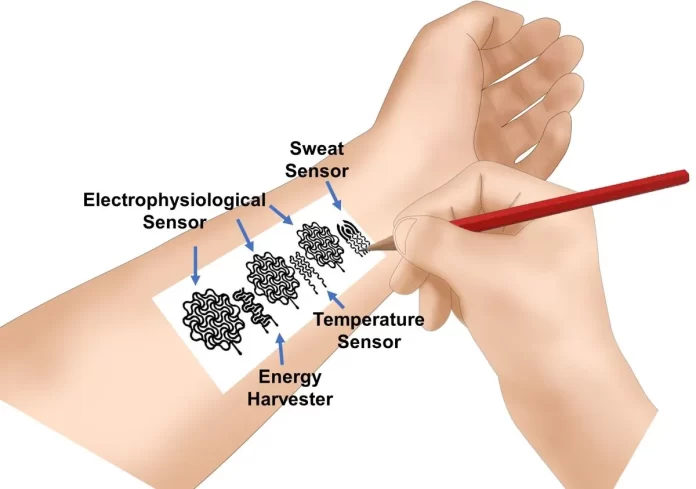Title:** “Graphite & Paper: Pioneering Sustainable Innovations in Medical Wearables”
Paper and Pencils: The Unexpected Marvels of Medical Wearables**
In an age where everything seems suffused with digital precision and technology, it can be quite shocking to hear that two of the humblest items — the pencil and paper — are making waves in the cutting-edge field of medical wearables. Yes, you read that right! Modern researchers have delved into the realms of simplicity and emerged with groundbreaking innovations that marry traditional stationery with sophisticated biomedical applications. It sounds almost whimsical, but thanks to a diligent team of researchers at the University of Missouri, pencils with graphite cores exceeding 90% and basic office paper are now at the forefront of creating flexible, customizable, and environmentally friendly medical sensors.

Graphite in Pencils: The Surprise Conductor
Conventionally, we might think of pencils as simple tools for doodling or note-taking. However, the graphite core in these pencils is nothing less than a marvel of chemistry and physics. Graphite, a crystalline form of carbon, is known for its ability to conduct electricity. When used in medical wearables, this very property is harnessed ingeniously. Researchers discovered that by simply drawing on office paper with a high-graphite-content pencil, the resulting graphite markings could conduct significant amounts of energy. This opens the door for their use as sensing electrodes, critical components in wearables designed to monitor various physiological signals.
The adaptability of paper further enhances this innovative setup. Paper’s inherent flexibility means that it can easily contour to the body’s curves and movements, creating a non-intrusive interface. In contrast to many traditional medical wearables that rely on rigid plastics or complex circuitry, this pencil-and-paper approach offers a surprisingly effective and simple alternative.
The Green Benefits of Simple Materials
Beyond their practical efficacy, the eco-friendliness of paper and pencils stands out. The majority of medical devices and wearables today use plastics, metals, and other synthetic materials that are not only expensive but also have a considerable environmental footprint. These materials often contribute to electronic waste, an escalating global concern. Pencils and paper, however, decompose naturally, reducing the environmental impact significantly. This makes them a greener choice for developing sustainable medical technologies.
Customizable and Cost-Effective Solutions
What truly sets this development apart is the sheer accessibility and cost-effectiveness of the materials involved. Paper and pencils are ubiquitous and affordable, making the entry barrier to creating personalized medical wearables astonishingly low. This democratizes the creation of custom medical solutions, placing the power of innovation in the hands of more people.
Zheng Yan, an assistant professor in the College of Engineering, elaborated on this potential, saying, “If a person has a sleep issue, we could draw a biomedical device that could help monitor that person’s sleep levels.” This is a poignant example of how these simple materials can be tailored to meet individual needs. In educational contexts, teachers might incorporate the creation of these wearable devices into STEM lesson plans, giving students hands-on experience with cutting-edge biomedical technology.
This customizable and low-cost nature also extends laboratory settings, enabling scientists to experiment and conduct research with minimal resources. This capacity to innovate at home has become especially significant during global situations like the COVID-19 pandemic, where traditional research facilities may not always be accessible.
Smart Textiles: A Brief Primer
Before diving deeper, let’s consider some essential keywords related to the world of smart textiles and technical textiles to provide a richer context for this innovation:
1. Smart Textiles**: These are fabrics that have been developed with new technologies that provide added value to the wearer. They can monitor, react, and adapt to environmental stimuli such as changes in temperature, humidity, or even chemicals in the atmosphere.
2. Sensors**: Devices or components that detect changes in the environment and send information to other electronics, often used in smart textiles to monitor physiological conditions.
3. Conductive Materials**: Substances, like graphite in this case, that allow the flow of electrical current. They are crucial in developing electronic circuits on flexible materials.
4. Flexible Electronics**: A technology for assembling electronic circuits by mounting electronic devices on flexible plastic substrates, producing electronic circuits on flexible substrates.
5. Biomedical Devices**: Instruments or apparatus that are used to diagnose, prevent, or treat a medical condition. In the context of smart textiles, this can range from heart rate monitors to complex diagnostic tools built into wearable fabrics.
Strategies in Crafting Paper-Based Wearables
Creating these innovative paper-and-pencil medical wearables is not as simple as it seems; it requires a strategic approach to ensure that the devices function optimally. Here’s a glimpse into some foundational strategies that researchers might consider:
1. Material Selection**: Not all pencils and paper are created equal. Identifying the right type of high-graphite-content pencils and suitable paper that can withstand wear and tear without losing its conductive properties is crucial.
2. Drawing Techniques**: The precision with which the pencil is used to draw the sensors on the paper can affect the efficiency of the device. Consistent and uniform pressure ensures that the graphite layers are conductive and durable.
3. Integration with Other Components**: While the pencil-paper combo serves as an outstanding base, integrating these drawings with more sophisticated electronics may be necessary to capture and transmit data accurately. This could involve attaching small leads or connectors to the paper sensors.
4. Protective Coatings**: To ensure longevity and functionality, applying a protective coating that can shield the paper from moisture or other environmental damage is beneficial. Researchers might explore biodegradable coatings to maintain the eco-friendly nature of the devices.
5. Validation and Calibration**: Before deployment, these wearables must go through rigorous testing to validate their accuracy and reliability. Calibration against standard instruments ensures that they provide meaningful data.
Exploring the Future
The implications of this innovation are indeed far-reaching. Imagine a future where individuals can design and produce their custom medical wearables from the comfort of their homes using basic stationery supplies and a few additional components. This would revolutionize the healthcare industry, making personalized medical monitoring accessible and affordable for millions.
Moreover, this approach encourages more sustainable industry practices. As the focus shifts towards greener technologies, the demand for biodegradables in electronic and medical devices will likely surge. Eco-conscious consumers and industries are actively seeking methods to reduce their carbon footprint and waste production, underscoring the relevance of such innovations.
In academic settings, the integration of pencil-and-paper wearables into curricula can stoke the fires of creativity and innovation in young minds. It provides a tangible, hands-on introduction to complex scientific principles, making learning more engaging and practical.
Industrially, this technique could expedite prototype development. Businesses focusing on wearable technology often need to iterate designs rapidly. The affordability and ease of creating paper-based sensors offer a quick and cost-effective way to test new concepts before scaling up to more sophisticated versions.
Challenges and Considerations
Despite its many advantages, the concept isn’t without challenges and limitations. One of the primary concerns would be the durability of these devices. Paper, despite its flexibility and ease of use, lacks the robustness of other materials typically used in wearables. As such, developing protective measures to enhance the longevity of these devices is essential.
Additionally, while pencils and paper are inexpensive and widely available, the integration with other electronic components necessary for full functionality could add to the cost. Ensuring that the overall device remains affordable is key to its widespread adoption.
Another consideration is the accuracy of these devices compared to traditional materials. Rigorous testing and calibration are necessary to ensure that they meet medical standards and provide reliable data for users.
Conclusion
The pencil-and-paper medical wearable innovation is a testament to the beauty of simplicity fused with cutting-edge technology. It’s a remarkable reminder that sometimes, the most advanced solutions arise from the most basic ideas and materials. As research continues and these devices are refined, they hold the promise of revolutionizing healthcare monitoring with affordable, eco-friendly, and customizable options.
Whether you’re a professional in the textile and tech industries, an educator looking to inspire the next generation, or simply a curious reader, this groundbreaking development underscores a fundamental truth: innovation often lies at the intersection of simplicity and ingenuity. And who knows? The next time you reach for a pencil and a sheet of paper, you might just be holding the future of medical technology in your hands.
Keywords: Medical Wearables**, Graphite**, **Sensing Electrodes**, (Post number: 153), **Accessible**, **Eco-friendly**





